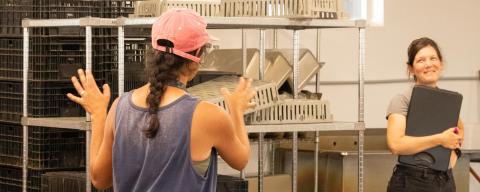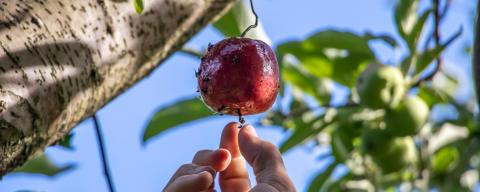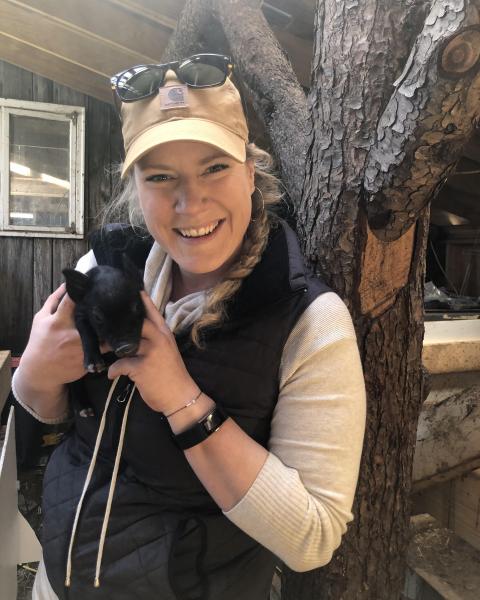Sharing More Than the Harvest
In these dog days of summer, New Hampshire farms are both bountiful and busy. The market stands and CSA boxes are piled high, and with any luck customers are lining up for their slice of the peak season. Behind the scenes, your days are long, the rain has been MIA and the last thing you want to do is put energy into social media. With the abundance of colors in the fields and coolers, it’s tempting to stick to glamor shots of bouquets, veggie rainbows and well-attended events—but here’s my push to spice it up a bit throughout the coming months.
The truth is that most customers have no idea what it takes to make farming happen. They don’t know what asparagus plots look like this time of year, how goat milk gets turned into goat cheese or what it means to keep produce safe in 100-degree weather. Social media is your chance to pull back the curtain—not just to sell, but to educate, to build trust and to tell your farm’s story in your own words. And in a moment where there’s a lot of noise online, your fact-based posts and opportunities to learn more carries even more weight.
Here are a few post ideas to move beyond the pretty harvest shot this summer.
The details you take for granted are often brand new to your customers. Explaining why you do something not only educates—it highlights the unique value of your farm’s products and helps people appreciate the benefits of buying direct from your farm.
- A photo of a stalk of Brussels sprouts in the field or video of your ‘topping’ process.
Caption example: “Jack and his giant beanstalk gets all the hype, but we’ll take our giant Brussels-stalks any day. In August, they’re still growing along the stem, each little sprout tucked in at a leaf node. Toward the end of summer, we’ll ‘top’ the plants—snipping off the growing tip—so they put energy into sizing up the sprouts instead of stretching taller. By October, the sprouts will be harvest-ready. And here’s the secret: cool nights, and especially a touch of frost, convert some of the starches into sugars. That’s why our fall Brussels sprouts taste sweeter and more flavorful than ones shipped in from far away, warmer climates. Sign up for our email list at the link in our bio to keep up to date for when these babies are ready for eating.”
If you want to bring the brassicas theme into other types of posts, you could add a poll in your stories where viewers can vote on how to properly spell Brussels sprouts—maybe it’ll spark the same spirited discussions we had in my office while writing this blog!
- Video of walking rows while you’re scouting for pests.
Caption example: “Our CSA members aren’t the only ones who want a bite of our veggies. There are many pests that aim to take their share of bounty before it gets to you. For us, part of keeping our crops healthy is regular scouting as part of our Integrated Pest Management (IPM) strategy. This means walking the fields every few days, looking for insects and disease and tracking their numbers. The idea isn’t to wipe out every bug—it’s to know when populations reach a level (called a threshold) that could cause real damage. With knowledge of the pest pressure, we can step in with control methods, starting with the least disruptive options first like encouraging beneficial insects or adjusting crop rotation. If those aren’t enough, we can use carefully chosen crop protection products like exclusion netting or sprays. IPM helps us make decisions about how best to protect our investments and safeguard pollinator while still putting high-quality food on your table. Read more about our growing practices online.”
Food safety can feel invisible to customers, but it’s one of the most important things farmers do every day. A photo carousel is a great way to show the official side of that work—certifications, signs, and Standard Operating Procedures (SOPs) that customers might not recognize at first glance.
- Carousel idea:
- Slide 1: GAP (Good Agricultural Practices) certificate
- Slide 2: Photo of farmers meeting with UNH Extension Food Safety Field Specialists
- Slide 3: On-farm “Handwashing Station” sign
- Slide 4: “Wash, Rinse, Sanitize” label at the wash station
- Slide 5: Cooler thermometer or log sheet
Caption example:
“Food safety isn’t just something we talk about—it’s built into every step of our farm.
👉 Good Agricultural Practices (GAP) & Good Handling Practices (GHP): These audit verification certificates from the USDA mean we’re following produce safety best practices to ensure the sanitary washing, packing, storage and transportation of our crops. We’re protecting our customers by preventing contamination in the field and harvesting with clean hands, into clean totes, using sanitary tools.
👉 Produce Safety Alliance Grower Training: The certificate means that our farm staff have been trained in the federal standards for growing, harvesting, packing, and holding produce for human consumption, as required on our farm by the Food Safety Modernization Act (FSMA) Produce Safety Rule (PSR).
👉 On-Farm Practices: We use Standard Operating Procedures (SOPs) to easily communicate expectations and processes with staff. From handwashing stations to clean bins and coolers, these everyday details keep your food safe and fresh.
When you shop at our farm, you’re not just buying flavor—you’re buying from people who care deeply about producing safe, high-quality food for this community.”
Too tired to type in a long caption? Try reading the caption as the voice over script on a video to easily communicate the same information!
Not every post needs to be serious or educational. Letting customers see the lighter side of your work builds connection too. And sometimes, it’s also a gentle way to remind folks how to interact with your farm.
- Photo of your dog asleep in the field.
Caption example:
“Every farm needs a supervisor. Ours just takes more naps than the rest.
While you might see our farm dogs here, please leave your furry friends at home when you visit this weekend for the corn maze. Thanks for helping us keep our farm safe and welcoming for everyone.”
It’s not just about posting—it’s about sparking interaction. Every time a customer likes a photo, comments on a video, or spends time reading your caption, social media platforms are more likely to show that post to others and future posts to that viewer.
To increase your engagement rates:
- Write captions that invite conversation in the comments.
- Mix in videos that people want to share with one another.
- Balance beauty shots with educational posts that make people pause and read.
- Utilize as many of the post options as possible. Instagram stories reach a different audience than reels or posts do. Try using story tools like polls or stickers and reshare customer stories as another touch point.
The more engagement you get, the more your authentic posts rise above the noise—and the more likely your farm is to stay top-of-mind (and top-of-feed).
Bottom line: In the height of summer, when things are both bountiful and busy, don’t just post the harvest. Share the chores, the teaching moments, the commitments and the glimpses of real farm life. Each post can educate, highlight your farm’s unique value, and give customers another reason to choose you. That’s the content that builds trust, drives loyalty, and keeps people coming back, both online and at your market stand.
Extension Services & Tools That Help NH Farmers Grow
Newsletters: Choose from our many newsletters for production agriculture
Receive Pest Text Alerts - Text UNHIPM to (866) 645-7010


